|
|
|
| Sliding Tables The job of a sliding table is to move stock past a cutter in a controlled manner. This same function can be done with other devices such as a miter gauge or a crosscut sled but a sliding table does this far better than either of those devices. Even a small sliding table will allow the user to easily crosscut a 24" wide sheet, something a miter gauge cannot do. Even the aftermarket miter-sleds cannot support a large piece of plywood like a sliding table or operate smoothly with a heavy load. There is quite a bit of differentiation among
the sliding tables available but most have the following advantages in common: |
| Requirements There are several factors to consider when looking for a sliding table, it is important to evaluate which features are most important to you and if possible see and use one in person. There are some requirements you may have that will point you towards one slider over another. The following are the major issues to consider to help narrow the field of choices: 1. Compatibility with mobile base 2. Cross cut capacity (stroke) 3. Static size of system (footprint) 4. Cost |
| The Ideal Slider There are some features that an ideal sliding table (for a cabinet saw) would have, they are: 1. Smooth and accurate travel with the ability to control the level of sliding friction. 2. Load carrying capacity that would allow it to support a 24x96 piece of ¾" Melamine on an end cut. 3. A means of keeping the guide bars free of dust, this keeps the sliding action smooth. 4. Crosscut fence between 36" to 48". 5. Crosscut fence that can be very easily and quickly removed and replaced, preferably with no loose components with the fence off, that means the fence and/or table must capture the attachment hardware. 6. Crosscut fence with an angle scale that is reliable and with enough resolution to be able to easily set the fence in ½ degree increments. 7. Crosscut fence with flip stop(s) that have a cursor to read a scale. An expanding fence section for stops past 48" would also be desirable. 8. Ability to very accurately and easily align the system for table height, travel parallel to blade, and slope to saw table in two axis. 9. Cutting capacity over 24". 10. Some form of stock clamp that is capable of clamping small stock and large plywood panels. This clamp must also be easily and quickly removed and replaced and not deform the crosscut fence under normal usage. 11. A table that is flat (whether it is solid or not) that can also be locked in a stationary position even with the leading edge of the saw table and also in a position fully retracted for loading sheet goods to keep the table from sliding into the blade until desired. Unfortunately, none of the sliding table attachments listed below have all these features of the "ideal". In reviewing the above list it is easy to notice that many of the benefits of a sliding table are directly proportional to the quality and ease of use of the crosscut fence. |
| Options There are a few companies that make sliding table attachments and there is a fair amount of differentiation between the models offered |
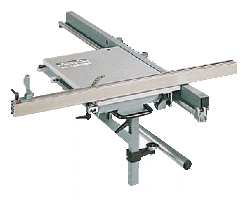 |
Delta The Delta attaches to the saw top and the cabinet and is guided by an upper bar and supported by a lower bar, this makes it a "walk through" type. Because it is only attached to the saw it will allow the use of a standard mobile base. The table is laminated OSB, not nearly as durable or flat as the materials used on other units. |
| Like most sliding tables the Delta allows the fence
to be positioned in the "forward" and "aft" table positions. The fence
in the forward position will be most natural to American operators but with the fence in
the aft position a greater capacity will be realized. With the fence in this aft position
the fence can be set at an angle but the miter scale is designed to be read with the fence
in the forward position only. Grizzly also sells a unit that looks the same and may be a little cheaper, the price of the Delta fluctuates quite a bit. The geometry and design of the Delta makes it naturally easy to move on its guides. Although the Delta isn't perfect, it is worth what it costs. For those interested, I have an article describing the modifications I made to a Delta unit. |
|
| Dewalt The Dewalt is specifically designed to fit onto the Dewalt 746 tablesaw, they do not sell this unit as a retrofit for other saw makes. That does not mean that the unit cannot be fitted onto other saws, it means you will have to figure out how to install it yourself and shoulder the risks that this entails; I do know of a few cases where the Dewalt has been installed onto cabinet saws. |
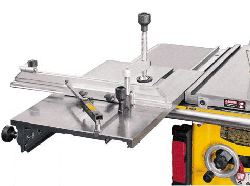 |
| The Dewalt is supported and guided by two roller
ball bearing assemblies very similar to a full extension drawer glide. These bearing units
are attached to a tray or pan that is in turn attached to the saw table and fence rails.
The Dewalt is unique in that it uses a telescopic mechanism instead of a guide rail. This
makes the Dewalt much smaller statically than similar capacity units which need a guide
bar roughly twice as long as their stroke. The Dewalt uses a solid cast iron table, a miter gauge slot is run in the sliding table as well. This accepts a miter gauge / crosscut fence very similar to the Osborne. The crosscut fence is quite a bit shorter than what is found on other sliding tables, this alone limits one of the beneficial features of a sliding table. The fence can be removed and replaced very quickly though. Due to the type of bearing assembly, the Dewalt has a very controlled feel to it when moved. However due to the design it cannot be adjusted for effortless rolling resistance like the Delta or Robland. The sliding action is good though and the mechanism has sweepers to keep it that way. Although the Dewalt isn't specifically designed to fit onto other saws, it has been done on more than one occasion. Here is an article (PDF) that describes one installation. |
|
| JessEm The newest entrant into the field of sliding tables is made by JessEm. The design going into production is not the same as the one pictured in FWW some time ago. The pre-production design used a crosscut fence system not too dissimilar to the one I made for my modified Delta slider. This allowed the pivot point to be close to the blade. This production design is different. In general form and construction, the JessEm unit greatly resembles a Format type sliding table. It uses some fairly large and robust aluminum extrusions for the sliding table itself as well as the supporting undercarriage. |
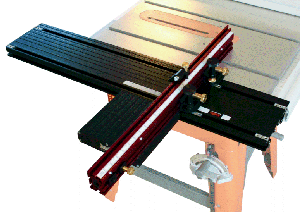 |
| The unit includes a small support table used to
increase the sliding table size somewhat as well as a crosscut fence with flip stop and
extension section. The fence can be positioned in 3 different spots on the
table, only one of these will allow the fence to be angled. With the fence in the
middle position it can be angled +45 and -45 degrees, not all sliders can do
negative angles. The small table attached to the side can also be moved. The only down side is that the fence cut scale needs to be re-calibrate if the fence is moved and there is no calibrated 90 degree position for the middle fence position. Overall the JessEm unit is quite good and sized well for everything except breaking up whole sheets of plywood. It is a little easier to align due to it's design. |
|
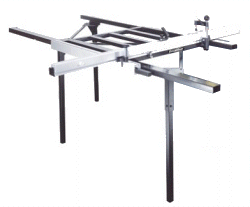 |
Excaliber Unlike most other units, the Excaliber is attached to the saw and supported by legs. These legs take up quite a bit of room statically, the unit doesn't take up any more space in use though, all sliders share the same dynamic space requirement. Unless the support legs were bolted to the floor it may be possible to throw the system out of alignment if they were inadvertently hit. The wide stance of the unit would allow it to easily support very heavy loads but this also makes the Excaliber incompatible with mobile bases. |
| All three of the Excaliber models all have open
frame tables. The slider uses a single guide bar on the far left of the unit and a support
bar near the saw. The unit is guided by roller bearings on the guide bar but the support
bar is a painted metal to plastic bearing surface. The crosscut fence comes with a crude
flip stop as well as a way of extending the fence for more support or a longer stop. A
hold-down clamp is also available. The support structure on the larger units are "walk through" types, the small unit is not. The small unit is designed with support legs like the larger versions but I think it would be possible to modify these so that they went to the saw cabinet instead of the floor. This modification would make the small slider mobile base compatible. |
|
| Exaktor The Exaktor is very similar to the Excaliber; with only minor differences; the same sizes, form, and description of the Excaliber apply to the Exaktor. Among the minor differences between units is that the Exaktor comes with sweepers to keep the rolling action clean and friction free, it also uses a stainless steel guide bar, the fence can be positioned at +45 and -45 degrees, and the table can be more easily removed. This last feature allows the option of using one carriage on two different machines. |
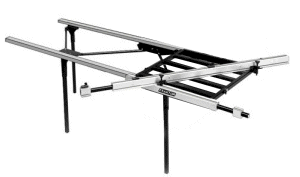 |
| There has been a fair amount of discussion in the
past regarding the Excaliber and Exaktor on various woodworking forums. An archival search
would probably reveal additional useful information on these units. |
|
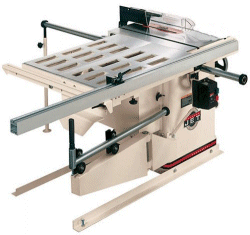 |
Jet The Jet is guided by a single guide bar much like the Delta unit. Unlike the Delta the Jet uses an "outrigger" for support, the outrigger design is fairly simple, a roller supporting the far end of the table that rides on a pivoting beam. An outrigger design is harder to align than a simpler guide bar arraignment but they should carry higher loads with less deflection. The table on the Jet is a two piece cast aluminum assembly with an open grid design. The bearings on the outrigger have sweepers. Conversely, (on the unit I inspected) there were no sweepers on the guide bar (where it is far more critical). |
| Due to its weight, Jet provides two angle pieces
than fit onto the base of the saw and extend underneath the sliding table quite a bit.
These stabilize the machine to prevent the saw from tipping over to the left. These angle
pieces are an obvious trip hazard when operating the device AND somewhat negate any
overall benefit of an outrigger design. The Jet would not be compatible with a mobile
base. The crosscut fence is long, it is obviously intended for sheet goods work. The stop block is fairly beefy and locks down solid. The stop block does not have a measurement cursor. There may be some "delta-like" issues with the fence removed, I didn't check too closely for this. The Jet seems too big and heavy for a cabinet saw and from a mechanical design point of view it looks like a kludge; it's more complicated than it needs to be, it's complexity doesn't add any benefit. Having said that though, I imagine it would work well for cross cutting large panels, I would prefer this unit over the Excaliber and Exaktor. If the saw was sufficiently counterbalanced or bolted to the floor the angle pieces could be omitted thus eliminating the trip hazard. |
|
| Mule Cabinet Maker / Rockler This unit appears to be nothing more than a bunch of parts obtained at a hardware store, there is little engineering effort involved in the design. What matters is how it works when assembled though. This unit is guided by two horizontal bars about 12" apart, the table is guided by 4 UHMW plastic bearings. The maker claims that "the bushings provide a much smoother operation than roller bearings", this is absolutely not true, the Mule has a great deal more friction than roller bearing systems. The support structure is attached to the saw, this will allow the use of a standard mobile base. However, the support structure prevents the operator from walking through with the cut. |
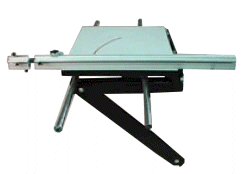 |
| Compared to other sliding tables the sliding action
is nowhere near as smooth on this unit. The alignment of the unit is also more crude than
the other sliding tables, basically it is done with shims, this doesn't really qualify as
alignment, it is assembly. The flip stop on the crosscut fence is also pretty crude,
hardly worthy of the name in fact. |
|
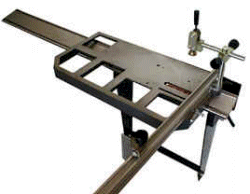 |
Robland The Robland is just like the unit on the X31 combination machine except it uses a special adapter kit to fit onto non-Robland machines. The Robland is guided and supported by two closely spaced guide bars attached at an angle to the saw. The close spacing of the guide bars and their attachment to the saw does not prevent the operator from walking along with the cut, this design would be considered a "walk through" type. The guide bars can also be displaced forward to get them out of the way when needed, this is a feature unique to Robland. |
| The Robland has sweepers to keep the rolling action
clean and friction free. The Robland can be obtained with either a small or large sized
cast iron table, the small table is solid, the large table has a grid area but it is
mostly solid (the large table is shown). Either table can be quickly removed to create
more shop space when needed although the large table would be cumbersome to move due to
its weight. The Robland comes with a very sturdy clamp and a single flip stop. The geometry and design of the Robland makes it naturally easy to move on its guides. This attachment will allow the use of a standard mobile base to be used with the saw. Laguna Tools (the only dealer) offers an accessory kit to aid in the alignment of the unit. |
|
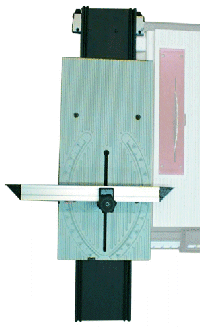 |
Ryobi SMT The SMT is NOT in the same league as the other aftermarket units in this article and is not offered for sale to fit onto non-Ryobi machines; as such a comparison isn't really fair . However, because others like to compare it to "real" sliders I'll offer this more realistic view of it. The Sliding Miter Table (SMT) is a small all aluminum unit that is attached to the rip fence rails of the Ryobi BT3100 tablesaw. The design of the saw is such that the SMT is movable on those rails and can be placed either on the left or right of the blade or between another movable accessory table on the saw. This design allows layout flexibility but also poses alignment problems as well. The crosscut capacity is fairly small, about 16 inches. With a shop modification it could be made to be about 24" though. The SMT travels 2.5" from the blade, closer than most aftermarket sliders; the 18" crosscut fence is short for a sliding table. The crosscut fence is easy to remove and replace but does not include a flip stop, a major deficit for a sliding table. |
| The "bearings" of the SMT are little
plastic tabs that by nature are consumable and their wear causes the device to need
periodic realignment. The "bearings" are really friction devices, compared
to roller bearings the travel is not nearly as smooth nor accurate. The major cause
for mis-alignment though is when the SMT is moved; the SMT will not maintain its alignment
very well when this occurs. The SMT can re-install with a run-out of 0.02" over
16" (a lot compared to other units). Even though there are alignment and wear issues with the device, if maintained, it will work well as intended (cutting comparatively small stock). The SMT is really more like a integrated crosscut sled than a real sliding table and should not be expected to do the work it's bigger cousins do. |
|
| Format Sliding Tables This form of sliding table is found on higher end European saws and are not typically offered as aftermarket items. I present them here for comparison purposes only. Note that compared to the aftermarket sliders the table (or "wagon") goes right up to the blade; by comparison, the aftermarket sliders are about 8 to 10 inches away. Also note that there are T-slots imbedded in the sliding table, these can be used to jig up special cuts as well as accept crosscut fences and numerous other accessories that are beyond the capability of other sliding tables to use. |
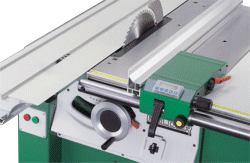 |
| This type of slider comes in a variety of sizes, typically 48", 78", 96", and even larger. These sliders use a telescopic bearing mechanisms, this makes the assembly only a little longer statically than the travel. For example, the Delta slider has a ~36" stroke, the guide bar is about "72" long; one of these sliders with a 48" stroke would be only about 48" long and it is all contained on the cabinet, there is little chance of accidentally bumping the slider out of alignment. | |
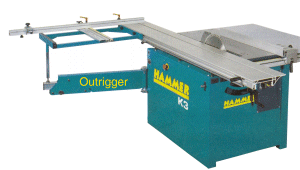 |
A common feature of this type of slider is known as an outrigger. The outrigger is a support table that has a large pivoting - telescopic arm attached to the cabinet. The outrigger tables can be removed and quickly reattached as desired; they allow the tables to be placed in different positions on the wagon as well. The outrigger allows for very long crosscut fences and the ability to easily support large (sometimes a few hundred pounds) loads and sheet goods. |
| It should be no surprise that this type of sliding table is expensive. The slider alone could cost as much as $1500, the outrigger could add almost another $1000. | |
| Rolling Your Own In addition to the commercially available units it would be possible to construct a sliding table on your own. To that end some of the woodworking magazines have articles describing how to build them. A sliding table isn't rocket science though and one should not feel constrained to these designs. However, it should be pointed out that building a machine with moving parts is not the same sort of work as making a piece of furniture. For example, a 0.01" bow in a raised door panel would go unnoticed on a piece of furniture, the same bow in the table on a slider would cause a problem in alignment. |
| Fine WoodWorking issue 101 Fine WoodWorking has had at least four articles on building a sliding table of one form or another but the issue 101 design is the most widely known among them. This unit was made of plywood and was guided by roller bearings riding on electrical conduit for guidance. The overall design is a cross between the Robland and the Mule in form. The overall form factor of the design is sound however the biggest problem is in the strength of materials needed to pull it off successfully and the tight tolerances that would need to be maintained in building it. In detail the problems with this system are: 1. No real method of alignment. 2. The method shown for building the bearing carriage is unlikely to get all four bearing sets in equal contact with the guide bars. This may result in a twisted carriage when force is applied to bring the bearings into contact. 3. In order to make a "twin bar compression" system like this one work a lot of force (comparatively) needs to be applied to the guide bars. The design has a means of applying the force but the materials will most likely deform measurably and it seems likely this would have an impact upon alignment and long term performance. 4. The structure is not tied to the saw table, it is tied to the base instead. This would probably allow some flexure of the support system with a heavy load and degrade the cut. 5. The crosscut fence is fairly crude. As designed I think this unit would be on the light duty side compared to the commercial units. Like the Mule, the support structure is attached to the saw, this will allow the use of a standard mobile base. Also like the Mule this support structure also prevents the operator from walking through with the cut. The geometry and design of the unit looks like it would be naturally easy to move on its guides IF it could be assembled properly. The Fine Woodworking design is a good model to follow if the
proper modifications were made to correct the design flaws as shown in the article. I
would not recommend building it though, it is unnecessarily complex and hard to
manufacture which makes it less likely to be a successfully built project. |
| ShopNotes Vol. 3. #15 My opinion of the ShopNotes unit is not very high. Compared to other designs and commercial units it would have much higher sliding friction and would be fairly light duty. This means it may not be strong enough to properly resist the cantilevered force of a 24 x 96 piece of plywood being crosscut, this may result in a poor quality cut or even kickback. The problems I see with this design are in these areas: 1. This unit relies on waxed laminate as a bearing and guide surface. These "bearings" are high friction - high wear surfaces compared to roller bearings on steel guide rails. 2. No real method of alignment. 3. It is highly likely there will be problems aligning the "bearings" to achieve even the same linear performance capable of a crosscut sled, there are too many factors conspiring against them. The most likely result will be a table that either binds or has too much slop in it. 4. The design of the crosscut fence in general is fairly crude. The 90 degree alignment method described in the article is prone to inaccuracies when placed in the 90 degree home setting. If building a shop-made sliding table, the ShopNotes design would be a bad model to start from. I would not attempt to build this design or any form of it. |
| Wood Issue 127, Oct 2000 The basic geometry of the Wood sliding table design is the same as the Delta slider except that is has all the flaws of the Delta and adds some MORE of its own while having NONE of the good features of the Delta unit. Some of the problems with the Wood design are: 1. NO real method of alignment. 2. The design of the sliding carriage is weaker than it should or could be and it is likely the table itself would be built with a measurable crown in it. 3. The designers of the Wood slider are relying upon the saw cabinet to be co-planar with the blade in two places. This is fairly unlikely and will probably cause an alignment problem. Due to their co-planar assumptions, no adequate method of compensating for errors in this regard is included in the design. 4. The crosscut fence on this design is also crude and has none of the characteristics of a good fence system. Instead of building this very bad copy
of a Delta I think it would be better to simply buy one; I certainly would not recommend
building this design as-is. |
| Scratch The design model of the Delta is good especially if one wanted to design and build one from scratch because the basic concept is more tolerant of flaws in materials and positioning. If I were to build a sliding table I would try and develop a design along these guidelines: 1. Single Guide Bar With a single solid steel guide bar it is much easier to control alignment and there are fewer tolerance stack-ups to deal with. The guide bar needs to be attached to the saw table, not necessarily the base. 2. Separate Table Height Control All the commercial tables I've seen couple the placement and / or alignment of the guide bearings with the height of the table. This just makes alignment unnecessarily complex. It is very easy to align a table if it is attached to a carriage using studs. 3. Upper Bearings Using a bracket to hold the bearings (that ride on the top of the guide bar) in a fixed position can be easily done if the table height is not set by their position; this simplifies the design and makes it more rigid. 4. Lower Bearings Using an eccentric stud is a very easy method to control how tightly the bearing rides against the bottom of the guide bar. This allows the alignment to be as true as the guide bar itself and control the amount of sliding friction without upsetting other alignments. 5. Support With a single guide bar some form of support will be required to keep the table level. This support could be in the form of another bar (like the Delta) or a triple pivot arm like those seen on some European machines (ie: MiniMax SC2). If the support were in the form of a bar it would be beneficial to attach the bar to the saw using a full length support to keep the lower bar from bending at the extreme ends of the stroke. The support bar could also be part of the same assembly as the Guide bar as are many European sliders (ie: Sheppach, Kity,…). An outrigger arm like those found on more expensive European machines could also be used but this would require a fairly substantial structure and pivot assembly if wood were used to build it. 6. Alignment The guide bar needs to have some form of fine alignment feature to make sure it is set parallel to the blade and not sloped with respect to the saw table. The table needs to have height adjustments to allow it to be set level with the saw table within 0.0" to +0.005"; the support method needs to have an alignment that allows the left end of the table to remain level within 0.0" to 0.005" of the saw table across the length of the stroke. |
| Alternatives Aside from the miter gauges and crosscut sleds mentioned previously, there are two more alternatives that bear some consideration. The first is a vertical panel saw. These typically use a portable circular saw and are used primarily for cutting sheetgoods. The prices, capability, and features vary quite a bit for these. This is a tool that can also be shop-built. The second alternative is actually a new saw with a built-in sliding table. None of the aftermarket sliders get much closer to the blade than about 10". Saws with built-in sliders get within 0" to 3" of the blade, this makes them inherently more useful because the entire sliding table can be used as a jig base. Sliding table saws of the type most would consider range in price from around $3000 to $7000, there are other important differences between these machines and cabinet saws equipped with slider attachments as well. |
| Recommendation When considering commercial units there really are only two basic sizes, those that can crosscut a 4x8 sheet and those than cross cut around 30". While it may seem best to just get a bigger unit that will do it all, larger units are more expensive and can take up substantially more room statically. In the bigger size, the Excaliber, Exaktor, and Jet provide the best support for large stock but I would lean towards the large table version of the Robland instead and use some form of support table when needed. I think the Robland would be a better all-around unit because it would be easier to slide than the others and I believe more accurate; the crosscut fence does have room for improvement though. The Robland isn't cheap but neither are any of the others capable of a 48"+ crosscut. For recommendations in the smaller size, if you aren't mechanically inclined I think the Delta / Grizzly would be a good choice, they aren't known for being perfect out of the box but they are still a good value. If you have a Dewalt saw or don't mind engineering it to fit another saw then the Dewalt would be a good choice. I do not recommend the Mule because of the high sliding friction, the lack of alignment features, and the close price of this unit compared to the Delta. Even so, the Mule is still better than a crosscut sled. If I were building a sliding table from scratch I would suggest something in the general form of the Delta because the geometry of the design is more tolerant of flaws. I would stay away from a telescopic design as a basis for a shop-made table unless you really want a challenge, it would probably cost more too. I am a very big proponent of using a tablesaw equipped with a sliding table. A sliding table will make a tablesaw fully twice as useful and safer to use when compared to a machine with out one. There is a truism attributed to sliding tables, "once you have used a sliding table, anything else will seem barbaric by comparison".
|